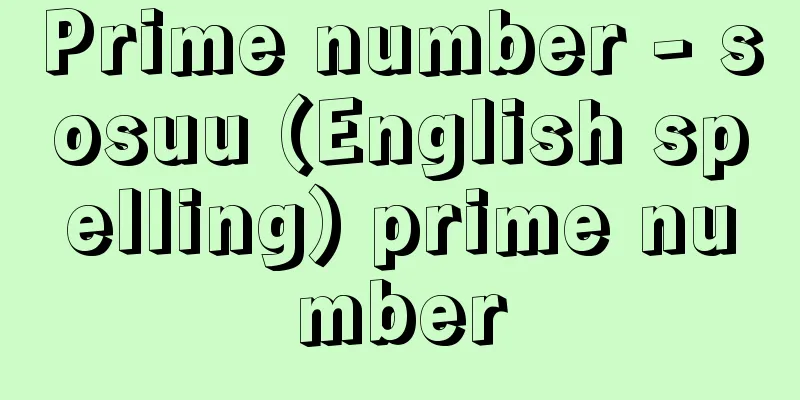Prime number - sosuu (English spelling) prime number

|
A natural number other than 1 that has no divisors other than 1 and itself is called a prime number. The symbol a|b is used to express when a natural number a divides a natural number b. A natural number p that is not 1 is a prime number, which can also be expressed as when, for natural numbers a and b, if p|ab, then either p|a or p|b holds. In Euclid's "Stoichia," it is proven that there are an infinite number of prime numbers. Let me state the proof in a modern style. Suppose 2, 3, 5, ..., p are all prime numbers, and consider the number N = (2 * 3 * 5 * ... p) + 1. N is not divisible by 2, 3, 5, ..., p. Therefore, N is a prime number because it has no divisors other than 1 and itself. Since N does not match any of 2, 3, 5, ..., p, this contradicts the assumption that they are all prime numbers. Therefore, the number of prime numbers is not finite. To create a table of prime numbers, a method called the "Sieve of Eratosthenes" is used. Even today, this method is basically improved upon to create a table of prime numbers. First, arrange the natural numbers in order starting from 2. First, keep 2 and eliminate multiples of 2. Next, keep the smallest number of the remaining numbers, 3, and eliminate multiples of 3. Next, keep the smallest number of the remaining numbers, 5, and eliminate multiples of 5. Continue in the same way to obtain a table of prime numbers. Eratosthenes was a Greek astronomer and geographer who lived around the 3rd century BC. Natural numbers greater than 2 can be expressed as a product of prime numbers. Furthermore, this representation is unique, except for the order. For example, 12 can be factorized as 3 × 2 × 2. Other possible prime factorizations are 2 × 2 × 3 and 2 × 3 × 2, but these all result in the same decomposition if the order of the factors is changed. Prime factorization and its uniqueness are described in Euclid's Stoichia, but its importance was not fully recognized until Gauss's Disquisitiones Arithmeticae (1801). Its importance is conversely recognized when the concept of integers is extended to complex numbers, where prime factorization and its uniqueness do not necessarily hold. A pair of prime numbers with a difference of 2, such as 11 and 13, or 17 and 19, is called twin primes. It is conjectured that there are an infinite number of twin primes, but this is currently an unsolved problem. [Tsuneo Adachi] Arithmetic progression theoremFor example, prime numbers with a ones-digit of 1 include 11, 31, 41, 61, and 71. Prime numbers with a ones-digit of 3 include 3, 13, 23, 43, 53, 73, and 83. Are there really an infinite number of each of these prime numbers? The theorem of arithmetic progressions answers the precise question of the infinity of prime numbers, and was first precisely proven by Dirichlet in 1837. Let a and d be mutually prime natural numbers. There are an infinite number of prime numbers in the arithmetic sequence a, a+d, a+2d, …, a+nd, …. For example, if a is 1 and d is 10, this means that there are an infinite number of prime numbers whose first digit is 1. The proof is The theorem on arithmetic progressions is more than just interesting; it is a fundamental theorem. It is a complete mystery whether the same thing can be said about polynomials of degree 1 or higher. For example, n 2 +1 (n is a natural number) [Tsuneo Adachi] Prime Number Distribution The number of prime numbers not exceeding a natural number x is expressed as π(x). For example, π(2)=1, π(10)=4, It is surprising that something as irregularly distributed as prime numbers can be approximated by a simple function, x/logx, and that this can be proven. Initial proofs used deep results in function theory, but Selberg gave a proof without using function theory (1949). [Tsuneo Adachi] Source: Shogakukan Encyclopedia Nipponica About Encyclopedia Nipponica Information | Legend |
|
1と自分自身以外に約数をもたない自然数のうち1でないものを素数という。自然数aが自然数bを割り切ることをa|bという記号で表す。1でない自然数pが素数であることはまた、自然数a、bに対してp|abならば、p|aまたはp|bが成り立つ、ともいいかえられる。 ユークリッドの『ストイケイア』のなかに、素数は無数に存在することが証明されている。その証明を現代風に述べてみる。2、3、5、……、pがすべての素数であるとし、N=(2・3・5・……・p)+1という数を考える。Nは2、3、5、……、pのいずれによっても割り切れない。したがって1と自分自身以外に約数をもたないのでNは素数である。Nは2、3、5、……、pのどれにも一致しないから、それらがすべての素数であるという仮定に反する。したがって素数の数は有限ではない。 素数表をつくるには「エラトステネスのふるい」と称する方法を用いる。現代でも基本的にはこの方法を改良して素数表をつくる。最初に2から順に自然数を並べる。まず2を残し、2の倍数を消していく。次に残った数のなかで最小の数3を残し、3の倍数を消していく。次に残った数のなかで最小の数5を残し、5の倍数を消していく。以下同様に続けて素数表を得る。なおエラトステネスは紀元前3世紀ごろのギリシアの天文学者・地理学者である。 2以上の自然数は素数の積として表せる。またその表し方は順序を除けば一意的である。たとえば12は3×2×2と素因数分解される。それ以外にも2×2×3,2×3×2と素因数分解が考えられるが、これらはすべて因数の順序を入れ換えれば同一の分解となる。素因数分解とその一意性についてはユークリッドの『ストイケイア』に記述があるが、その重要性は、ガウスの『数論研究』Disquisitiones Arithmeticae(1801)に至るまで十分認識されなかった。その重要性は、複素数にまで整数の概念を拡張するとき、かならずしも素因数分解とその一意性が成り立たないことによって逆に認識される。 11と13、17と19のように差が2の素数の組を双子素数という。双子素数は無数に存在するという予想があるが、現在未解決の問題である。 [足立恒雄] 算術級数の定理たとえば一位の数が1である素数としては11,31,41,61,71などがある。また一位の数が3である素数としては3,13,23,43,53,73,83などがある。はたしてこれらの素数はそれぞれ無数にあるだろうか。このような素数の無限性を精密にした疑問に答えるのが算術級数の定理であって、1837年ディリクレによって初めて正確に証明された。 いま、a、dを互いに素な自然数とする。等差数列a,a+d,a+2d,……,a+nd,……のなかには無数に素数が存在する。たとえばaを1、dを10とすれば、一位の数が1である素数が無数に存在することを意味する。証明は 算術級数の定理は単なる興味を超えた、基本的定理である。同じことが一次以上の多項式についていえるかは、まったく未知の問題である。たとえば [足立恒雄] 素数分布自然数xを超えない素数の個数をπ(x)で表す。たとえば 素数のように不規則に分布するものがx/logxという簡単な関数によって近似され、しかも、それが証明されるというのは驚くべきことであろう。初期の証明には関数論の深い結果が用いられたが、セルバーグによって関数論を用いない証明が得られている(1949)。 [足立恒雄] 出典 小学館 日本大百科全書(ニッポニカ)日本大百科全書(ニッポニカ)について 情報 | 凡例 |
Recommend
Carl Gustav Patrik de Laval
1845‐1913 Swedish engineer. After studying at Upps...
Baryshnikov, Mikhail
Born January 28, 1948 in the Soviet Union, Baryshn...
dikastai
...Solon abolished the laws of the Dracon except ...
Maritime satellite
...For this reason, a new system called GPS that ...
Ghost monkey - Ghost monkey
…The New World Capuchin monkey (illustration) of ...
Dagon
Dagon was a Semitic god. In Hebrew, he was called...
Aquinas, T. - The Devil
…But in medieval sacramental theology, the focus ...
Thorpe, Jim
Born May 28, 1888, near Prague, Indian Territory (...
Naoyoshi Kumagai - Naoyoshi Kumagai
A poet of the late Edo period. A samurai of Iwaku...
Genocide
The planned and systematic destruction of a group ...
Torroja, E. (English spelling) TorrojaE
...The expression of irrationality through ration...
Habotan (Leaf peony) - Habotan
The original species is a plant of the Brassicacea...
Roan Ozawa
Year of death: July 11, 1801 (August 19, 1801) Yea...
The story of the one-horned hermit
…An ancient Indian epic. Along with the Ramayana,...
Orphanage - Kojiin
A social welfare facility that houses and cares f...









